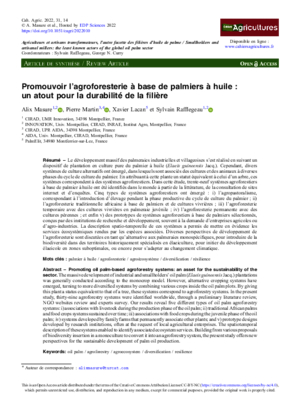Promoting oil palm-based agroforestry: an asset for the sustainability of the sector
Abstract – The massive development of industrial and village palm groves was carried out following a
planting device in pure culture of the oil palm (Elaeis guineensis Jacq.). However, various
alternative cropping systems have emerged, in which crops and animals are associated with various
phases of the palm crop cycle. By giving this plant a status equivalent to that of a tree, these
systems correspond to agroforestry systems. In this study, thirty-nine agroforestry systems
based on oil palm have been identified throughout the world from the literature, consultation of sites
internet and surveys. Five types of agroforestry systems have emerged: i) agropastoralism,
corresponding to the introduction of livestock during the productive phase of the palm cultivation cycle; ii)
traditional African agroforestry based on palm trees and food crops; iii) agroforestry
temporary with food crops in juvenile palm groves; iv) permanent agroforestry with
perennial crops; and finally v) prototypes of agroforestry systems based on selected palms,
designed by research and development institutions, often at the request of agricultural companies or
agro-industries. The spatio-temporal description of these systems has made it possible to highlight the
ecosystem services provided by associated species. Various prospects for the development of
agroforestry are discussed as an alternative to monospecific palm plantations, to introduce
biodiversity in territories historically specialized in oil palm cultivation, to initiate development
oil palm in suboptimal areas, or to adapt to climate change.

